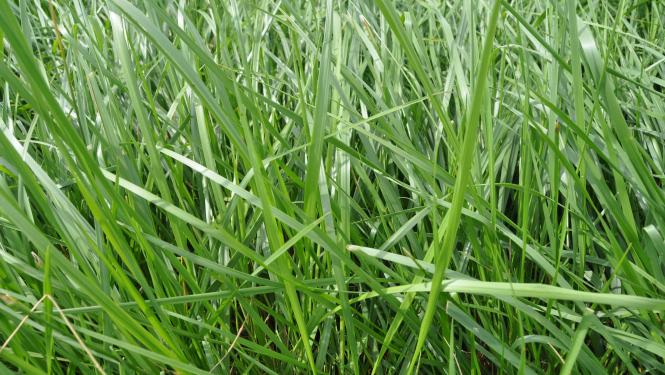Adaptation to climate and soil type are not the only considerations when it comes to selecting a cool-season perennial. Farm constraints, management style, and long term goals should all be part of the decision. Take a minute to evaluate where your forage system is now and where you want it to be. From there, you can work towards selecting the cool season perennial that will help you get there.
Novel Endophyte Fescue
While fescue is not the most palatable grass for livestock, it has one big advantage: stockpiled forage. Fescue is the only cool season forage that can be stockpiled in the winter without losing severe amounts of quality. Setting aside acreage of fescue to graze in December, January, and February will reduce the need to feed hay, which can translate to increased farm profitability. Fescue does respond well to fertilization, but overall fertility needs are moderate. Should be grown in clay based or heavy loam soils, does not tolerate sandy land well.
It is important to note that novel endophyte fescues do contain an endophyte, but it is NOT toxic to livestock. The fungus present helps the plant tolerate drought, grazing pressure, and other environmental challenges, but does not cause health and production issues like the endophyte in KY-31.

Endophyte Free Fescue
These plants are improved Tall Fescues that have no endophyte present. These are more palatable than KY-31 and are very well adapted to the southeast. As with the novel endophyte fescues, they still stockpile well and have moderate fertilizer requirements. These varieties work very well with short term hay rotations because the removal of the endophyte does make these plants less tolerant to drought and other environmental stressors.
Orchardgrass
Orchardgrass is a high quality grass that is also highly palatable. This soft-leaf grass is more sensitive to drought and cutting height than novel endophyte fescues, but is excellent for pushing livestock gains in the fall and spring. This grass has moderate fertilizer requirements, should be in clay or heavy loam soils, and can tolerate “wet feet” much better than fescue.
Festulolium
Festulolium is a combination of the ryegrass family and the fescue family. Different varieties will favor characteristics of each species differently. For the southeast, it is important to focus on varieties that favor Tall Fescue characteristics. Festulolium varieties that favor Tall Fescue do stockpile well, are typically higher quality than Tall Fescue, and have moderate fertilizer requirements.
Bromegrass
Bromegrass is typically the highest quality cool season perennial grass, even if harvested after seeding out. It is well adapted to a range of soil types and responds very well to fertilization. It has been approved for use in waste management plans. Bromegrass plants live about 3 years, but stands will persist longer than that because they are prolific reseeders. These plants need to be given the opportunity to drop seed each year to keep the stand thick and productive. Bromegrass does not tolerate continuous grazing, so this grass fits best on farms that are utilizing a rotational grazing system. Be cautious of powdery mildew- a fungus that will harm the plants if a lot of vegetation is left during wet conditions. Graze quickly if wet, cloudy conditions are present.
It is important to keep in mind that perennials have slower growth that annuals. They can be grazed or cut for hay during the first year, but this should be done cautiously. Be mindful of grazing start and stops for each perennial grass and be sure not to graze the new seeding too soon or take it down too low. For more details, contact your local dealer.